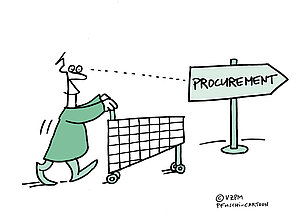Procurement
Definition
Procurement is a process of buying or obtaining goods and/or services from external parties. It includes all processes, from purchase planning to making the purchase and contract administration. Because procurement focuses on the suppliers outside the parent organisation, it procures resources (people, tools, material and sub-deliverables) that are not available from within the organisation. This competence element also includes choosing or taking the optimal procurement routes, which should fit the long-term objective of the client but also the organisation (e.g. partnership, joint ventures, etc). These routes can mean sharing funding, expertise, etc, but also entail the risks of failing on the market.
Purpose
The purpose of this competence element is to enable the individual to obtain the best value possible from the chosen suppliers or partners and thus deliver the best value for the buyer and the organisation.
Description
The process of procurement enables organisations to acquire the necessary resources that these organisations do not possess or produce themselves (at least, in the amounts needed). Organisations’ procurement policies are often imposed top-down. When procurement aspects involve a substantial portion of a project, or when there are multiple procurement items, the procurement approach should be documented in a procurement plan covering at least:
- Types of contracts to be used
- Roles and responsibilities
- Supplier selection procedures
- Subcontracting rules
The management of procurement is either performed by individuals assigned to the project, delegated to specialists or departments (e.g. legal department, finance department), directed by the programme level responsible for organisation-wide procurement and strategic partnerships, or even influenced by the portfolio level. Strategic considerations such as sustainability, lifecycle costs and reduced overheads from the development of positive relationships with suppliers, partners or buyers, and the risks connected with them, must also be taken into account. For each item to be acquired, the basic process includes defining needs, identifying potential suppliers or partners, obtaining technical and financial proposals, selecting a preferred supplier or partner and negotiating an agreement with the preferred supplier, making the purchase and contract administration. The inventory, disposals and other relevant functions are often considered as indirect procurement. The amount of effort devoted to each step should correspond to the size and complexity of the item being procured.
An exchange of goods or services between units of the same legal entity may sometimes be treated as procurement. In such cases, the procurement should be treated as if it were between independent parties and subject to the same degree of control.
Key competence indicators
Agree on procurement needs, options and processes
Needs and options identification is the process of determining which resources or services are to be procured or for which aspects of the project that partners will be acquired. This may result from shortage or lack of internal availability or a conscious choice to acquire resources externally (make or buy strategy).
The procurement options, routes, acquisition requirements, tender documents and selection criteria must be agreed on. The individual manages this process, often in close cooperation with or delegated to specialised departments or the management, ensuring that relevant information is made available and that the relevant internal and external stakeholders are informed.
Measures
- Defines reasons (based on needs) for procurement or partnership
- Prepares, produces or collects the necessary information as input to the procurement subject matter experts
- Defines tender documents and selection criteria based on needs
- Supports procurement preparation processes and procedures
Contribute to the evaluation and selection of suppliers and partners
The individual ensures that the possible partner organisation and/or other experts, suppliers or partners are identified, evaluated and selected. In this selection process, the defined tender documents and selection criteria are applied (or, if no supplier is able to deliver in accordance with the terms of reference, reformulated). These tender and selection criteria and the procurement process may be subject to formal regulations (e.g. in Roman-Germanic law countries). The selection process itself often includes various steps, such as requests for information (RFI) and requests for proposal (RFP) or requests for quotation (RFQ). If the procurement leads to any partnership models and the bidding process is not being used, the individual shall follow a careful process to safeguard the quality of the selection of partners.
Measures
- Launches request for quotation (tender), if necessary in cooperation with the procurement function
- Outlines and defines the various steps in a supplier selection process
- Defines and explains the contents of tender documents
- Defines and uses the selection criteria
- Aligns with formal procurement regulations (international, national and branch-specific)
- Assesses the specifics of the procurement and suggests partnership models (e.g. joint ventures, long-term partnerships, etc)
Contribute to the negotiation and agreement of contractual terms and conditions that meet project objectives
Once the supplier or partner is selected, a negotiation process may follow, in order to reach agreement about the contractual terms and conditions. The individual oversees this process and makes sure that the negotiators have a clear mandate, in close cooperation with purchasing and/or legal specialists.
The contracts may vary in form, level of detail, contract duration, terms and conditions, penalties, applicable law and many other aspects. The individual takes care that these aspects closely relate to and serve the objectives of the project and the organisation.
When the contract negotiations are complex and long-lasting, sometimes a precontractual arrangement is agreed on to make preliminary work or deliveries possible.
Measures
- Defines a negotiation mandate and sets objectives to be negotiated
- Distinguishes different contractual forms and their implications for the project
- Knows contractual terms and conditions and reflects their implications for the project
- Negotiates a contract by establishing price, availability and customisation possibilities and procurement schedules
Supervise the execution of contracts, address issues and seek redress where necessary
Contract performance means the continuous supervision of the supplier or partner once the contract has been established, to ensure the correct and timely execution of the contract. In case of deviations from the contract, the individual has to take action or escalate, whenever necessary, within his or her own organisation. If one or more of the contract terms (such as delivery time, quality, etc) are not met, the individual must take action to address this issue and if possible solve it. This may include various techniques, from soft notices to serious renegotiations, and the individual needs to know when to use each of these. After the techniques are applied, if the contract partner remains in default, the individual should take or invite a decision as to whether a penalty should be claimed or whether to seek redress from the contract partner by other means. This situation may include legal action or involve legal specialists, always consulting the management in order to align with the strategic procurement long-term policies.
Measures
- Implements measures to manage contract performance
- Identifies deviations from the contract
- Handles contractual breaches by taking corrective measures (e.g. talks, renegotiations, etc)
- Involves – in the case of difficulties in renegotiations – legal, logistic and/or procurement functions of the organisation
- Handles contractual disputes and claims issued by the supplier
- Concludes and ends the agreed business relationship when either the project is in risk or all of the obligations in the contract have been met


